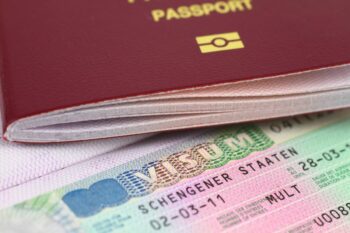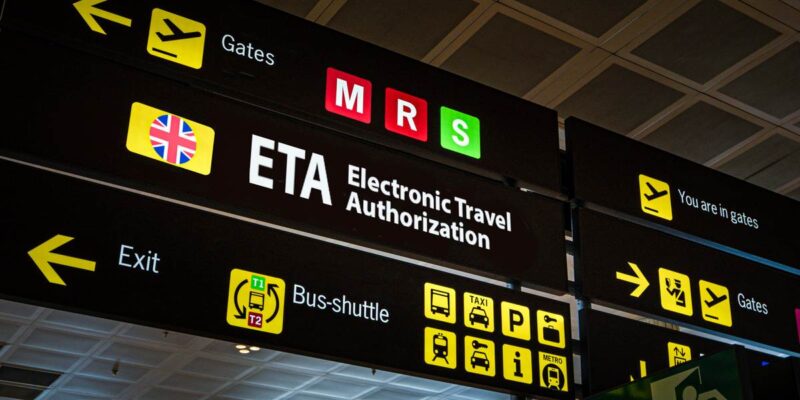Who Needs It, How to Apply, Costs, and Expert Travel Tips

In this article, you’ll learn which countries are included in this visa-free travel zone, who needs a visa, how to apply, coverage requirements, and tips for your European adventure.

Schengen Visa-Compliant Travel Insurance
- Designed for travelers who need a Schengen Visa to enter Europe
- Meets the €30,000 medical coverage requirement
- Includes emergency evacuation, repatriation, and a visa letter
What Is a Schengen Visa?
A Schengen visa is a short-stay permit that allows travel within 29 European countries known collectively as the Schengen Area.
With it, you can enter and travel freely between member countries and exit the region without having to go through internal border checks.
This visa is designed for tourism, business trips, and family visits that last up to 90 days in any 180-day period. It is not valid for long-term stays, work, or study.
Read More: The Most Popular Travel Destinations in 2025
Schengen Area Countries
The Schengen Area consists of 29 European countries that have abolished internal border controls, allowing travelers to move freely across member states without passport checks.
This includes most EU countries – 25 out of 27 EU member states – and four non-EU countries: Iceland, Liechtenstein, Norway, and Switzerland.

As of 2025, the 29 countries are:
- EU Member States: Austria, Belgium, Bulgaria, Croatia, Czechia, Denmark, Estonia, Finland, France, Germany, Greece, Hungary, Italy, Latvia, Lithuania, Luxembourg, Malta, Netherlands, Poland, Portugal, Romania, Slovakia, Slovenia, Spain, and Sweden.
- Non-EU Members: Iceland, Liechtenstein, Norway, and Switzerland.
- Special Cases: Monaco, San Marino, and Vatican City are not official members of the Area but allow entry under the same rules, making them accessible with a valid Schengen visa.
Once you enter any Schengen country, you can travel freely throughout the region without additional border checks. This makes travel across Europe easier for both residents and visitors.
This seamless travel is made possible by the Schengen Agreement, originally negotiated in 1985, by Belgium, France, Germany, Luxembourg, and the Netherlands.
Since then, the agreement has expanded to include these 29 countries, simplifying travel throughout Europe for millions.
Fun Fact! Thanks to the Agreement, you can cross borders within the Area on foot or by bicycle without border checks. For example, pilgrims walking the Camino de Santiago can seamlessly cross from France or Portugal into Spain, and cyclists traveling across Europe can enjoy breakfast in Switzerland and lunch in Austria, Germany, Italy, or France, all without anyone checking their passports.
Schengen Area Exclusions
Not all European countries belong to the Schengen Area. For example, Ireland and Cyprus are not part of it, although Cyprus is an EU member.
The United Kingdom, including Gibraltar, left both the EU and the Schengen Area. Danish territories like the Faroe Islands and Greenland are also excluded. French overseas territories are part of the EU but not included.
Non-EU European countries outside the zone include Albania, Andorra, Armenia, Azerbaijan, Belarus, Bosnia and Herzegovina, Georgia, Kosovo, Moldova, Montenegro, Russia, Serbia, Turkey, and Ukraine.
Read More: Travel to Europe: Health, Safety, and Insurance Advice
Types of Schengen Visas
There are three main types of Schengen visas, depending on your travel plans:
- Single-Entry: This is valid for one entry and allows a stay of up to 90 consecutive days within any 180-day period. Once you leave, you cannot re-enter without a new one.
- Multiple-Entry: This permits multiple entries and exits within a 180-day period, but your total stay cannot exceed 90 days in that timeframe.
- Airport Transit (Type A): This is required for certain nationalities transiting through the international transit area of a Schengen airport without entering the Schengen Area.
Before applying, consider whether you plan to stay continuously in the Area, need to enter and exit multiple times, or are simply passing through.

The 90/180-Day Rule Explained
Schengen visas permit a maximum stay of 90 days within any rolling 180-day period. This means you can spend all 90 days consecutively or split them across multiple trips, but the total time spent within the zone cannot exceed 90 days in any 180-day window.
For example:
- With a single-entry visa, your stay begins when you enter a Schengen country and lasts up to 90 days until you leave the Area.
- With a multiple-entry visa, you can enter and exit multiple times, but the combined time spent in the zone cannot exceed 90 days within the rolling 180-day period.
 Track Your Stay. Exceeding the 90-day limit can result in fines, visa refusals, or entry bans, so it’s crucial to keep track. To avoid overstaying, use the Schengen Calculator to monitor your travel days and ensure compliance with the 90/180-day rule. If you plan to stay longer than 90 days or want to extend your visa, you must apply for a different type.
Track Your Stay. Exceeding the 90-day limit can result in fines, visa refusals, or entry bans, so it’s crucial to keep track. To avoid overstaying, use the Schengen Calculator to monitor your travel days and ensure compliance with the 90/180-day rule. If you plan to stay longer than 90 days or want to extend your visa, you must apply for a different type.
Who Needs a Schengen Visa?
Unless you are a citizen of a country with visa-free entry, you must apply for a Schengen visitor visa. To find out if you need one, visit the European Commission’s interactive requirements map or consult their list of exempt and non-exempt countries.
If you are from an exempt country but have previously been denied entry to the Schengen Area, you must apply for a Schengen visa.
Before applying, also check whether you qualify for visa-free travel or will need the new ETIAS travel authorization, which will become mandatory for many travelers starting in the last quarter of 2026. (More on that later.)
Visa Requirements for Travel and Transit
Certain nationalities need a Schengen transit visa when passing through airports or seaports in the Area.
Passport holders from Afghanistan, Bangladesh, Congo (DRC), Eritrea, Ethiopia, Ghana, Iran, Iraq, Nigeria, Pakistan, Somalia, and Sri Lanka must have a transit visa to change planes within the Schengen Area.
Some other countries may also require an airport transit visa, but only for specific Schengen countries. For details, see the full chart on the European Commission’s website.

Visa Requirements for U.S. Citizens Traveling to Schengen Countries
For short stays, U.S. citizens and most travelers from other English-speaking countries can enter the Schengen Area without a visa.
However, if you are a temporary or permanent U.S. resident but not a citizen (for example, a green card holder), you may need a Schengen visa based on your country of citizenship.
Check your specific requirements before traveling.

Schengen Visa-Compliant Travel Insurance
- Designed for travelers who need a Schengen Visa to enter Europe
- Meets the €30,000 medical coverage requirement
- Includes emergency evacuation, repatriation, and a visa letter
Upcoming European Travel Authorizations
As visa policies evolve, travelers should be aware of new pre-travel authorization systems being rolled out across Europe.

Here are two major programs to keep on your radar if you’re planning a trip in the near future:
The UK ETA Starting in Late 2025
In late 2025, the United Kingdom will launch its own Electronic Travel Authorization (ETA) for visitors from visa-exempt countries.
The UK ETA is not a visa but will be required for travelers from the United States, Canada, Australia, and other eligible nations.
For full details on who needs the UK ETA, how to apply, costs, and validity, see The UK ETA: What Travelers Need to Know for 2025.
The New ETIAS Travel Authorization Starting in Late 2026
Starting in the last quarter of 2026, all visa-exempt travelers must apply through the European Travel Information and Authorization System (ETIAS) to enter 30 European countries. These include the 29 Schengen Area countries plus Cyprus.
If you are traveling from countries such as the United States, the UK, Canada, Australia, New Zealand, Mexico, or Japan, you must complete the ETIAS application process. The official ETIAS website has a complete list of eligible countries.
For full details on who needs ETIAS, how to apply, costs, and validity, see ETIAS for Travel to Europe: What to Know Before 2027.
Schengen Visa Travel Insurance Requirements
When applying for a Schengen visa, you must show proof of valid travel medical insurance. This is mandatory and must meet specific criteria set by the member states.
Your policy must:
- Be valid in all 29 countries in the zone
- Cover the full duration of your stay
- Include a minimum of €30,000 in emergency medical protection, including repatriation
Some embassies may also request a confirmation letter from your provider verifying that your plan meets their requirements. Since rules can vary slightly by embassy or consulate, always double-check with the relevant authorities.

We’ll Help You Choose the Right Travel Plan
Compare top-rated travel insurance plans that satisfy Schengen visa requirements for your upcoming trip to Europe.
Read our detailed article on Schengen Visa Insurance Requirements for a full breakdown of these coverage requirements and to compare plans that comply.
Protect Yourself. Although travelers from visa-exempt countries aren’t required to carry this specific coverage to enter Schengen states, having adequate protection is strongly recommended to safeguard against medical emergencies, trip cancellations, and other unexpected expenses abroad. Learn more about the benefits of travel insurance.
How to Apply for a Schengen Visa
You must apply at least 15 days before your trip, but you can submit your application up to six months in advance.
Steps to Apply
- Choose the embassy or consulate of either:
- The first Schengen country you will visit, or
- The country where you will spend the most time during your trip.
- Assemble the required documents and complete the application form.
- Submit your application and fees according to the consulate’s instructions (in person, by mail, or online).
- Attend an in-person interview when called by the consulate.
For detailed instructions and the application form, visit the European Commission’s official website.

Application Requirements
You must provide documents demonstrating you meet the following conditions:
- A valid passport with at least three months’ validity beyond your planned departure from the Schengen Area.
- A recent photo meeting ICAO standards.
- A travel medical plan covering the Area, as detailed earlier.
- Supporting documents showing the purpose of your visit, proof of accommodation, evidence of sufficient financial means, and your intention to return home.
Some applicants may also be fingerprinted when they submit their application.
Read More: The European Health Insurance Card (EHIC)
Schengen Visa Fees
The standard fees are:
- €90 (approx. $106 USD) for adults
- €45 (approx. $53 USD) for children aged 6-12
- Reduced fees for nationals of certain countries:
- €35 ($41) for Armenia, Azerbaijan, and Belarus
- €67.50 ($79.50) for Cabo Verde
The following applicants are exempt from paying a fee:
- Children under 6 years old
- Students at all education levels and their accompanying teachers traveling for study or educational training
- Researchers traveling for scientific research purposes
- Travelers aged 25 or under representing non-profits attending conferences, seminars, sports, or cultural events organized by those non-profits
- Family members of EU/EEA citizens
Additional fee waivers may be available, so check with the consulate where you apply.
Where to Apply
You must submit your application at the embassy or consulate in your country of residence or the one you are traveling from.
- If you plan to visit multiple Schengen countries, apply at the consulate of the country where you will spend the most time.
- If you will only be transiting through the Area, apply at the consulate of the country where your transit occurs.
- If your first country of entry differs from where you will spend most of your time, and your stay there is short, you may apply at the embassy of your first country of entry.
For all Schengen visa types, you will typically need to attend an in-person interview.
Processing Times
You must apply at least 15 days before your trip, and no earlier than 6 months in advance. The ideal time to apply is 1 to 3 months before your travel date.
Most applications are processed within 15 calendar days, but some can take up to 45 days if additional documentation or checks are needed. Apply early to avoid delays.
Common Reasons for Visa Denial
Your application may be denied if you fail to meet requirements or your documentation is incomplete or unclear.
Some common reasons for refusal include:
- A criminal record or prior visa overstays
- A passport that is invalid, damaged, or suspected to be fraudulent
- Missing or incorrect supporting documents (such as travel itinerary, proof of funds, or accommodation)
- Inadequate financial resources for the trip
- Not meeting the required travel insurance criteria

What to Do If Your Application Is Denied
If your visa is denied:
- You have 15 days to file an appeal
- You’ll receive a written explanation from the consulate or from a partner country acting on its behalf (e.g., France handling applications for the Netherlands)
- The application fee is non-refundable, and you’ll need to pay again if you reapply
Before reapplying, make sure to fully address the reasons for the refusal. This may include updating your passport, submitting stronger financial documentation, correcting paperwork, or obtaining compliant travel coverage.
Schengen Area Travel Tips
Understanding how Schengen rules work will help you make the most of your time in Europe while avoiding costly mistakes or travel disruptions.
Here are some essential tips to keep your travels smooth and stress-free.
- Respect the 90/180-Day Rule: You can stay in the Area for up to 90 days within any 180-day period. This includes time spent across all member countries. Overstaying—even by a few days—can lead to fines, entry bans, or trouble securing future permission to enter.
- Track Your Travel Days Carefully: Use the short-stay calculator to stay within your limit. Record your entries and exits, especially if you hold a multiple-entry permit.
- Don’t Assume You Can Extend: Short-term entry is generally non-extendable from within the region. If you need more time, consult a consulate in your home country before your trip to explore long-stay or residency options.
- Digital Nomads and Remote Workers: Short visits may be possible under a tourist entry, but working remotely is a legal gray area in some countries. Avoid drawing attention to commercial activity, and look into specific digital nomad programs if you plan to stay longer.
- Border Checks Still Happen: Although internal borders are usually open, occasional ID checks or police stops are possible. Always carry your passport and entry documents, especially on cross-border trains and buses.
- Keep Copies of Important Documents: Store digital and paper copies of your passport, visa, travel coverage, and bookings in case of loss or emergency.
- Apply Early: Start your application process as early as six months before your trip. Delays can happen, especially in peak travel seasons.
- Enjoy the Perks of Open Travel: Once inside the Area, you can travel freely between countries by train, car, plane, or ferry without additional border checks.
Need Coverage for Your Schengen Visa?
Read our detailed article on Schengen Visa Insurance Requirements for recommended travel plans that meet all the visa criteria.
Alternatively, click on the link below to compare our top travel plans.

We’ll Help You Choose the Right Travel Plan
Compare top-rated travel insurance plans that satisfy Schengen visa requirements for your upcoming trip to Europe.
Read More
- Travel Insurance for Europe
- Passport vs. Visa: What’s the Difference?
- Travel Insurance and Your Travel Visa
- How to Choose a Travel Medical Plan
- Vaccine Requirements for Traveling Abroad
Author: Kamela Hutzley is a Senior Editor at International Citizens Insurance. She is a native New Jerseyite who recently emigrated to Halifax, Nova Scotia. In late 2022, she spent a month each in Ottawa, Montreal, and Quebec City, before deciding on Atlantic Canada for the long haul. She’s traveled to Hawai’i, Jamaica, France, Spain, the UK, Ireland, Greece, Switzerland, Germany and the Netherlands. Kamela writes about International Life Insurance, Travel insurance, and Health topics as well as advice for expats and travelers.
